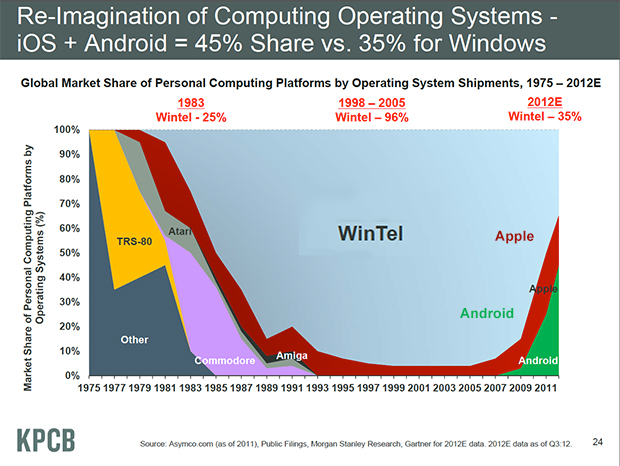December 2012: Mary Meeker’s slide vividly depicts the relentless march of mobile OS into the heart of desktop QWERTY keyboard land

I downloaded the latest Mary Meeker slide deck earlier today, and the image above – a composite of information from Asymco, public filings, Morgan Stanley Research and Gartner – jumped out at me as I flipped through her fresh insights.
Wintel is the blue background color, and the image vividly depicts the changing operating system landscape. After the brief Commodore Amiga/AtariST/Apple renaissance in 1991, the market has been dominated by Microsoft until the new hockey stick of Apple and Android hit its stride in 2008…ironically just as the global banking credit and fraud crisis choked commercial activity.
It’s a hell of an image to burn into your synapses: Mary’s deck is titled ‘internet trends’ and of course the unseen in this image underpinnings of the new hockey stick are mobile and cloud infrastructure, with a return to a variation of the thin client/beefy servers that were dominant prior to the PC’s triumphant ascent from the 80’s to 1999, the height of the Microsoft Explorer browser dominated dot com boom.
Today the vast majority of employees are provisioned with PCs and Windows. Walk into a major hospital or other large complex enterprise and you’re likely to see a lot of screensavers with the Windows XP logo drifting around on them while they are locked. The plasticy PC’s and dorky look and feel of old versions of Windows is as ubiquitous as the locks on the doors and keycard systems…and they won’t be going away any time soon.
While modern mobile device evolution matures people will watch closely but not take action until they see firm foundations, which is what Microsoft have provided for many past lifetimes in technology dog years.
The world today is focusing on the software that increasingly powers everything thanks to ubiquitous broadband and mobile connectivity, and the barriers to creating applications that leverage the connection to the billions strong digital population of the planet have never been lower.
We’ve gone from the Web 2.0 ‘beta’ Google and down web applications (‘fail early and often’) of five years ago, where you enticed your prospects to help alpha and beta test your concepts, to the currently febrile and ephemeral ‘apps’ era.
Large, rigid business entities are going to take years to move to newer technologies, but the bigger question is how many large, rigid entities will be left by then? A hospital is a text book example of an enterprise anyone can understand: medical records, literal life and death, tight and volatile regulatory control, lots of moving parts and legal complexity.
The form factor of the enterprise application access physical device may well change over time, evolving from mouse and keyboard to slates for those constantly on their feet and with light input needs, but that’s akin to the CSS layer of code – the display layer. These types of transactional business entities are not bound to Windows as the operating system/display layer as cloud becomes the dominant connectivity via browsers and apps.
If PC sales dry up that cuts off a big part of Microsoft’s operating system revenue, as Zack Whitacker has already discussed here on ZDNet. The reality is that many businesses are composed of multiple smaller business entities, often with their own P&L, HR and IT. Take these plus small and medium sized firms and you really begin to see the shift to the post PC, mobile world where documents and email are less dominant as contractual and communication devices, and where mobile context is king.
Microsoft of course recognize this and are now wide awake and bombarding the planet with advertising for their new efforts. However “Windows: the smartphone reinvented around you” may not compute in a world used to Windows meaning cathode ray tubes, plastic QWERTY keyboards and mice….and Seinfeld and Gate’s cosy comedic timing around the future of computers being ‘moist and chewy like cakes so we can just eat them while we’re working’.
The chart above tells the story, and the major societal seismic shifts in the way we relate, communicate and collaborate with each other individually, in defined groups and en masse is breaking molds faster than new ones can be created. I saw the (well worth seeing) film ‘Chasing Ice‘ this weekend – ‘the story of one man’s mission to change the tide of history by gathering undeniable evidence of climate change‘ – Meeker’s slide reminds me of the temperature change claims and epic footage of elemental destruction of gigantic ice plains in that film.